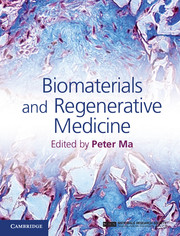Book contents
- Frontmatter
- Contents
- List of contributors
- Preface
- Part I Introduction to stem cells and regenerative medicine
- Part II Porous scaffolds for regenerative medicine
- Part III Hydrogel scaffolds for regenerative medicine
- Part IV Biological factor delivery
- Part V Animal models and clinical applications
- 25 Bone regeneration
- 26 Biomaterials for engineered tendon regeneration
- 27 Advancing articular cartilage repair through tissue engineering: from materials and cells to clinical translation
- 28 Engineering tissue-to-tissue interfaces
- 29 Models of composite bone and soft-tissue limb trauma
- 30 Tooth development and regeneration
- 31 Dentin–pulp tissue engineering and regeneration
- 32 Dental enamel regeneration
- 33 Hair follicle and skin regeneration
- 34 In-vitro blood vessel regeneration
- 35 Stem cells for vascular engineering
- 36 Cardiac tissue regeneration in bioreactors
- 37 Bladder regeneration
- Index
- References
25 - Bone regeneration
from Part V - Animal models and clinical applications
Published online by Cambridge University Press: 05 February 2015
- Frontmatter
- Contents
- List of contributors
- Preface
- Part I Introduction to stem cells and regenerative medicine
- Part II Porous scaffolds for regenerative medicine
- Part III Hydrogel scaffolds for regenerative medicine
- Part IV Biological factor delivery
- Part V Animal models and clinical applications
- 25 Bone regeneration
- 26 Biomaterials for engineered tendon regeneration
- 27 Advancing articular cartilage repair through tissue engineering: from materials and cells to clinical translation
- 28 Engineering tissue-to-tissue interfaces
- 29 Models of composite bone and soft-tissue limb trauma
- 30 Tooth development and regeneration
- 31 Dentin–pulp tissue engineering and regeneration
- 32 Dental enamel regeneration
- 33 Hair follicle and skin regeneration
- 34 In-vitro blood vessel regeneration
- 35 Stem cells for vascular engineering
- 36 Cardiac tissue regeneration in bioreactors
- 37 Bladder regeneration
- Index
- References
Summary
Bone biology
Bone is a complex tissue-organ system integrating multiple components in hierarchical layers of molecular cues, cellular communities, and networking highways. Bone moves through space and time in a dynamic manner modulated by homeostatic mechanisms nuanced through a coordinated intercalation of biological and biomechanical rhythms. The price we vertebrate species pay for maintaining this magnificently orchestrated tissue-organ is daunting.
Bone is the most metabolically expensive tissue in the human body. For every ounce of bone, a pound of soft tissue is required for maintenance [1]. Moreover, the human skeletal system must be rugged in order to handle years of cyclic loading at high forces on the order of kilonewtons, and highly sensitive to the calibrated kinetics of calcium and phosphate release in order to maintain meticulously modulated ion levels [2]. Consequently, the intrinsic design of bone and the dynamics that sustain it are an instructional core for regenerative bone therapeutics.
In this chapter we will introduce the profoundly compelling biodynamic structural marvel that gives shape to the amorphous mass in which it is wrapped and provides the fulcrums and pulleys that propel our anatomy along the avenues and boulevards of our towns. We will probe the blueprint of bone as a defining mold that guides and mentors attempts in the laboratory to design and develop compositions to repair and regenerate this structural tour de force.
- Type
- Chapter
- Information
- Biomaterials and Regenerative Medicine , pp. 449 - 477Publisher: Cambridge University PressPrint publication year: 2014



